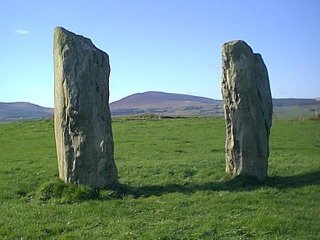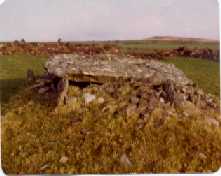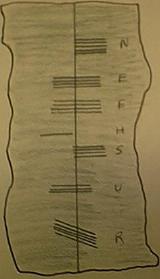All over our area there is evidence of human habitation going back almost 5000 years.Scattered across our hills and valleys are monuments of the pre-Christian era.There are "Ring Forts", "Souterrains," "Fulacht Fiadhs", "Cromlechs", "Stone Circles", and "Galláin" in abundance.Most of these monuments were built during the Neolithic Age(New Stone Age) about 3,500 years B.C. and during the Bronze Age which began 2,000 years B.C.
 |
This stone pair is in the townland of Caherbaroule. We are not too sure what they were used for, but they were probably a ritual or a cermonial site like a stone circle. These gallain are almost 3m in height. We know from research that there was a third one, but it has disappeared. |
Initially they may have been hunter-gatherers but eventually learned the skill of agriculture and established permanent settlements.They lived in houses built of wooden frames thatched with long grass and rushes. A group of these would have been protected by a ring fort. They worshiped the sun at stone circles and stone alignments. They buried their dead under cromlechs, dolmens, galláin and Ogham stones. They had a unique system of cooking deer, boar, etc. in Fulacht Fiaidhs. The evidence of our ancestors early existence is preserved for us by the existence of these ancient monuments in our locality.
| |

|
The Celts invaded Ireland and most definitely Rusheen around 600 B.C. This is obvious from the amount of forts found in the area. Perhaps the most remarkable of these is the two ringed fort found in Cahirbaroule.
They sometimes dug underground caves in their forts and used them as hiding places in times of trouble. There are a large number of these "Souterrains" scattered around the Rusheen area, expecially in Kilberrihert, Delish and Cahirbaroule.
 |
This ringfort is to be found in Caherbaroule. It is mainly made of stone. Ringforts were enclosed farmsteads built in the late Bronze Age. The circular ditch acted as a defence against all sorts of attackers. |
Sometimes the Celts lives in a Crannóg. This was rather like a fort except that it was situated on a lake. Around the Crannóg was a wooden pallisade or fence. Within the Crannóg were a number of circular buildings. The walls were made of timber stakes intertwined with branches or flexible twigs and plastered with mud or daub. The roofs were usually tatched. The advantage the Crannóg offered the inhabitants was that any attacker had to either come by boat, cross the guarded timber bridge or cross the zig zag stepping stones. Here is a model of a Crannóg we made in school.

The Celts had a unique system of cooking their food in what are known as "Fulacht Fiadhs". They heated stones in a fire and when they were very hot, dropped them into a trough of water until it came to the boil and cooked the meat. Many of these are to be found around the area also.
| |

|